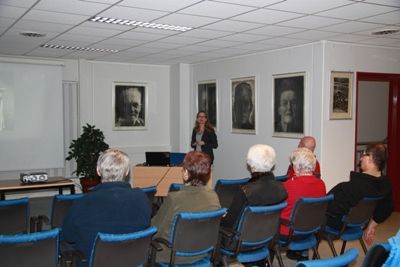On the 24th and 25th of February, The Museums for Coastal Heritage and Reconstruction in Finnmark hosted the historian, Vibeke Kieding Banik from The University of Oslo. Banik gave a speech on Norwegian-Jewish history. The speech was the first in a number of lectures that are to be held in our museums regarding the Holocaust, and is a result of our involvement in the Comenius project TeacMem. Banik gave three speeches in two days. The first speech was held in The North Cape Museum. The following day she spoke to the pupils at Hammerfest Videregående skole (Hammerfest High School), and later at the Museum of Reconstruction for Finnmark and Northern Troms in Hammerfest. Banik gave a thorough presentation of Jewish life in Norway, starting with the very first Jewish immigration to Norway in the middle of the 19th century. Less than a century later, the Norwegian Jews were on their way to the German death camps. Banik underlined that the mass deportation of the Jews from Norway to these camps mirrored deportations elsewhere in Europe. Finally she outlined the hardships most went through when returning to their country. A question still controversial in Norway and a focal point in Banik’s speech, was why ordinary Norwegians did not do more to prevent the deportations of the Jews that lived amongst them. This question, and the multiple possible answers to it are not pleasant,but crucial to our understanding of why the Holocaust was made possible. Banik ended her speech by drawing parallels between the anti-Semitism that preceded the Holocaust and the present rhetoric regarding different minority groups of today.
Norwegian-Jewish History at the museum of reconstruction for finnmark and northern troms
On the 24th and 25th of February, The Museums for Coastal Heritage and Reconstruction in Finnmark hosted the historian Vibeke Kieding Banik from The University of Oslo. Banik gave a speech on Norwegian-Jewish history. The speech was the first in a number of lectures that are to be held in our museums regarding the Holocaust, and is a result of our involvement in the Comenius project TeacMem.



